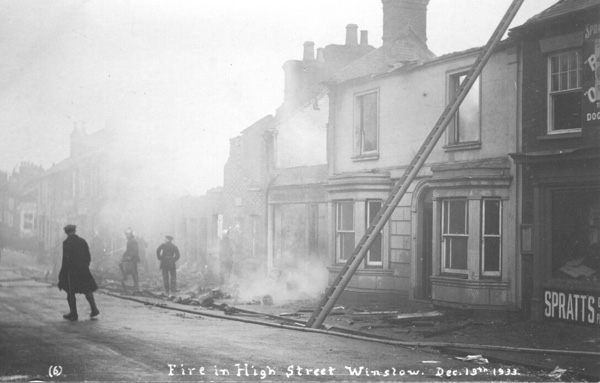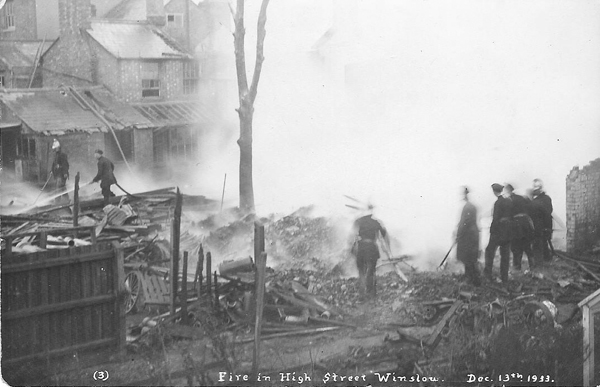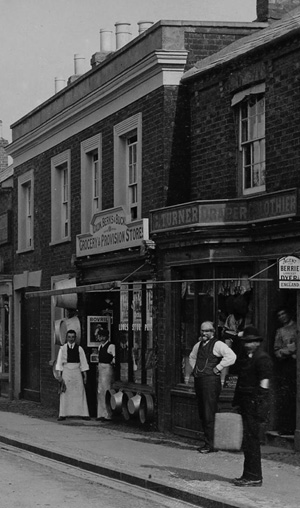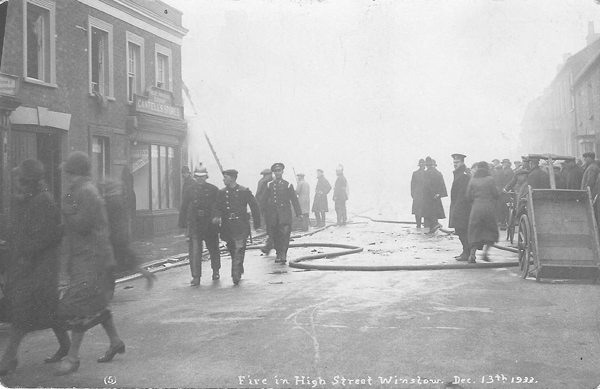
The great Winslow fire of 1933
by Ed Grimsdale
Winslow differs from most English market towns in not being built around a river. Until the third decade of the 20th century, Winslow had no piped water supply and water came from small, private pumps. The lack of a sound supply of flowing water had limited Winslow’s growth over the centuries, as the town depended on wind-power and, as we’re beginning to appreciate once again, “the wind bloweth where it listeth”. In 1930, Winslow had only 1500 inhabitants.
Thus, the scene was set for the events described in The Times in December 1933:
| A large section of the High Street of the small market town of Winslow, Buckinghamshire, was this morning threatened with destruction by fire. The townspeople with buckets of water drawn from domestic pumps, were for some time engaged in an unequal struggle with the flames, which were aided by a strong wind. Eventually, the shops of a grocer, a hairdresser, and a firm of builders, two cottages and a double-fronted house were destroyed. They were buildings of two storeys and were used as dwellings, and some of the occupiers were in bed at the time of the outbreak. |
The potential situation was little different from the Great Fire of Buckingham in 1725 when one third of the town was destroyed despite the best efforts of the local population.
“Fire, Fire! Send for… the Winslow Fire Brigade.”
They arrived very soon (within five minutes).
“Oh dear,” thought the chief fireman, “This is a big one. From where can I get enough water?”
“Quick! To the Gas Works, comrades.”
“Oh dear!” … the Gas Works was along Station Road but the brigade didn’t have sufficient hose-pipes to cover the distance.
By now, Buckingham and Aylesbury Fire Brigades had been summoned, but there was ice on the roads.
Something must be done, NOW!
“Captain Lambton has fire fighting equipment up the road at Redfield.”
“I’ll send you some hose-pipes on a lorry,” came the public-spirited reply of this hunt-obsessed, ex-Etonian who’d been the High Sheriff of Bucks in 1927.
It was decided to fetch the water a whole mile from the stream known as Washbrook (Great Horwood Road).
Winslow and Lambton hoses didn’t stretch that far, but…
“Ding, Ding, Ding”
The fire-tenders from Buckingham and Aylesbury arrived on the scene and by threading all of the hoses together, there was just enough!

The Times report continued:
| The fire had taken such a hold on the three shops and the three dwelling houses that their destruction was inevitable. The three brigades therefore concentrated their efforts on saving adjoining property. … the firemen succeeded in preventing the fire extending farther along the street. |
No doubt, stalled plans to bore deep and provide a reliable public water supply were expedited.

NOTES
You can read the full report from the Buckingham Advertiser of 16 Dec 1933: click here (PDF file of 2.6MB)
The builders' premises mentioned belonged to Gibbards. The hairdresser was Leonard Page. The houses destroyed were the homes of Mr & Mrs Tucker and Mr & Mrs Welsh. Much of the site remained derelict until a block of flats was built there in the 1980s. Cantell's grocers (100 High Street) largely survived the fire - you can just see the building through the smoke in the top photo above, behind the helmeted fireman, and clearly in the photo below. The photo on the right shows Cantell's (at the time of the photo called the Oxon, Berks and Bucks Grocery and Provision Stores) and the adjacent Turner's Drapers (also destroyed) before the fire. After the fire, the hoses were frozen to the road, which caused difficulties when there was a chimney fire at Midgley's the ironmongers on the next day. The Parish Council launched a relief fund for the victims of the fire: four families were made homeless, and lost nearly all their possessions. |
 |
 |
|
See also:
